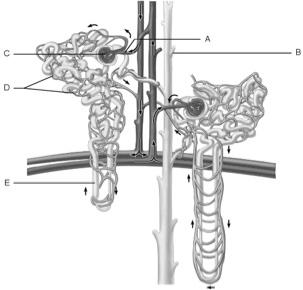
Glomerulus
C
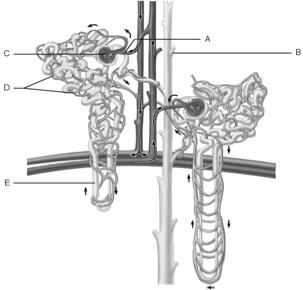
Afferent arteriole
A
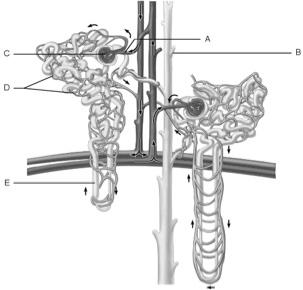
Collecting duct
B
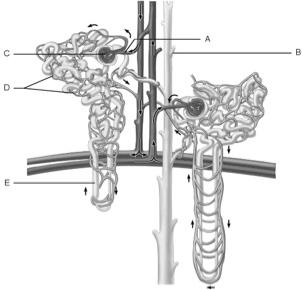
Loop of Henle
E
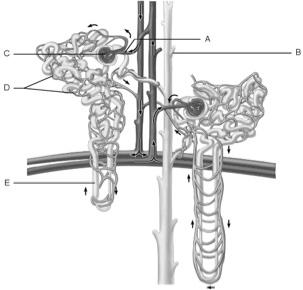
Peritubular capillaries
D
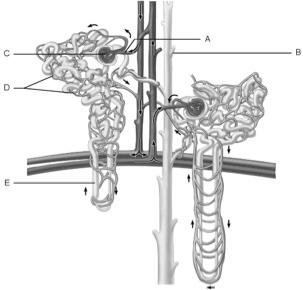
Structure most closely associated with granular cells
A
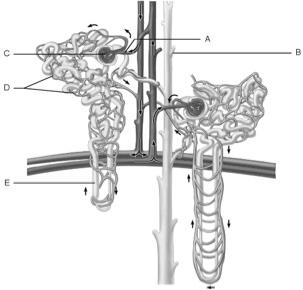
Medulla of the kidney
E
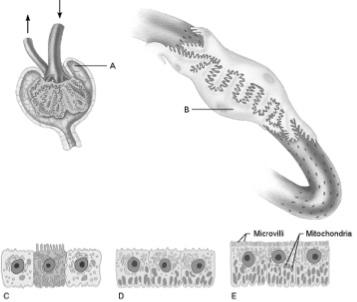
Podocyte
B
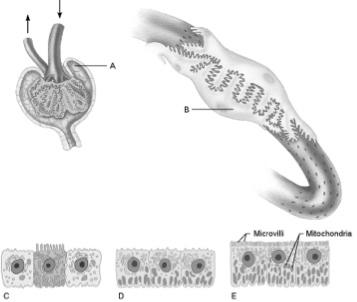
Is composed of simple squamous epithelium
A
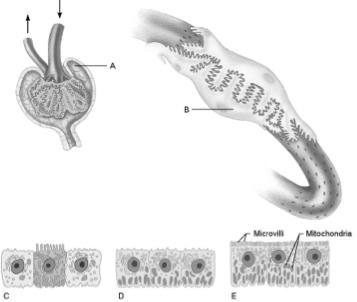
Collecting duct cells
C
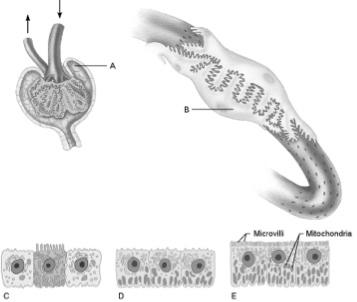
Proximal convoluted tubule cells
E
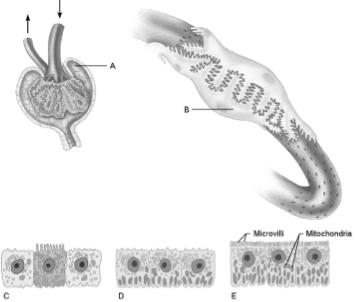
Filtrate at the site of these cells is about the same osmolarity as blood plasma
E
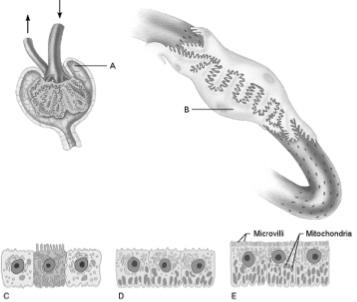
Cells that are the most active in reabsorbing the filtrate
E
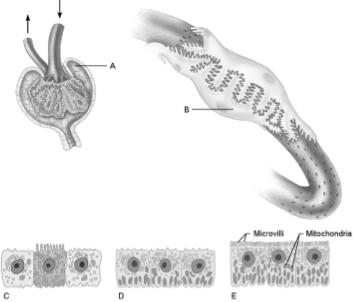
Cells that reabsorb virtually all the nutrients
E
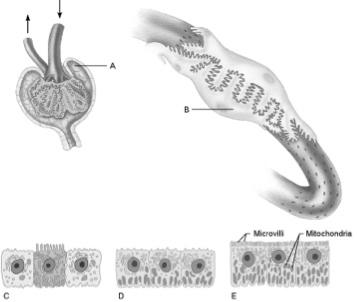
Cells that are most affected by ADH
C
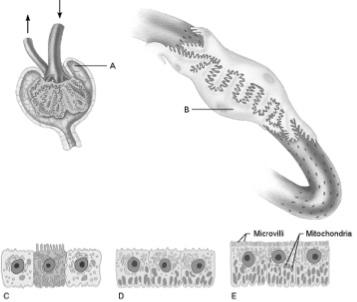
Almost no water is absorbed in these cells
D
Proximal convoluted tubule
A) Site at which most of the tubular reabsorption occurs.
B) Blood supply that directly receives substances from the tubular cells.
C) Site of filtrate formation.
D) Site that drains the distal convoluted tubule.
A) Site at which most of the tubular reabsorption occurs.
Glomerulus
A) Site at which most of the tubular reabsorption occurs.
B) Blood supply that directly receives substances from the tubular cells.
C) Site of filtrate formation.
D) Site that drains the distal convoluted tubule.
C) Site of filtrate formation.
Peritubular capillaries
A) Site at which most of the tubular reabsorption occurs.
B) Blood supply that directly receives substances from the tubular cells.
C) Site of filtrate formation.
D) Site that drains the distal convoluted tubule.
B) Blood supply that directly receives substances from the tubular cells.
Collecting duct
A) Site at which most of the tubular reabsorption occurs.
B) Blood supply that directly receives substances from the tubular cells.
C) Site of filtrate formation.
D) Site that drains the distal convoluted tubule.
D) Site that drains the distal convoluted tubule.
True/False Questions
If the GFR is too low, needed substances may pass so quickly through the renal tubules that they are not absorbed and instead are lost in the urine
False
True/False Questions
In the kidneys, the countercurrent mechanism involves the interaction between the flow of filtrate through the loop of Henle of the juxtamedullary nephrons (the countercurrent multiplier) and the flow of blood through the limbs of adjacent blood vessels (the countercurrent exchanger). This relationship establishes and maintains an osmotic gradient extending from the cortex through the depths of the medulla that allows the kidneys to vary urine concentration dramatically
True
True/False Questions
The ureter transports urine from the kidney to the urinary bladder
True
True/False Questions
Water reabsorption through the proximal convoluted tubule is termed obligatory water reabsorption, whereas water reabsorption through the distal convoluted tubule is termed facultative water reabsorption
True
True/False Questions
The position of the kidneys behind the peritoneal lining of the abdominal cavity is described by the term retroperitoneal
True
True/False Questions
The entire responsibility for urine formation lies with the nephron
True
True/False Questions
Urine is 95% water by volume
True
True/False Questions
The act of emptying the bladder is called voiding
True
True/False Questions
Glomerular filtration is an ATP-driven process
False
True/False Questions
In the absence of hormones, the distal tubule and collecting ducts are relatively impermeable to water
True
True/False Questions
The collecting duct is impermeable to water in the presence of ADH
False
True/False Questions
The urethra contains an internal sphincter of smooth muscle
True
True/False Questions
Angiotensin II is a substance made by the body to lower blood pressure during stress
False
True/False Questions
Aldosterone is a hormone that causes the renal tubules to reclaim sodium ions from the filtrate
True
True/False Questions
Blood pressure in the renal glomerulus is lower than in most parts of the body in order to conserve body water
False
True/False Questions
The proximal convoluted tubule is the portion of the nephron that attaches to the collecting duct
False
True/False Questions
Urea is reabsorbed in the loop of Henle
False
True/False Questions
Incontinence is the inability to control voluntary micturition
True
True/False Questions
The myogenic mechanism reflects the tendency of vascular smooth muscle to stretch
False
True/False Questions
An excessive urine output is called anuria
False
True/False Questions
Tubular secretion is effective in controlling blood pH
True
True/False Questions
The trigone is so named because of the shape of the urinary bladder
False
True/False Questions
Atrial naturetic peptide inhibits sodium reabsorption
True
True/False Questions
The macula densa cells are chemoreceptors that respond to changes in the urea content of the filtrate
False
True/False Questions
Blood in the urine may be a symptom of bladder cancer
True
True/False
Obligatory water reabsorption involves the movement of water along an osmotic gradient
True
True/False Questions
Having a kinked ureter is called renal ptosis
False
The mechanism that establishes the medullary osmotic gradient depends most on the permeability properties of the ________.
A) loop of Henle
B) glomerular filtration membrane
C) collecting duct
D) distal convoluted tubule
A) loop of Henle
Urine passes through the ________.
A) renal hilum to the bladder to the ureter
B) pelvis of the kidney to ureter to bladder to urethra
C) glomerulus to ureter to renal tubule
D) hilum to urethra to bladder
B) pelvis of the kidney to ureter to bladder to urethra
Which of the following is not associated with the renal corpuscle?
A) a podocyte
B) a vasa recta
C) a fenestrated capillary
D) an efferent arteriole
B) a vasa recta
An increase in the permeability of the cells of the collecting tubule to water is due to a(n) ________.
A) decrease in the production of ADH
B) increase in the production of ADH
C) increase in the production of aldosterone
D) decrease in the concentration of the blood plasma
B) increase in the production of ADH
The urinary bladder is composed of ________ epithelium.
A) transitional
B) simple squamous
C) stratified squamous
D) pseudostratified columnar
A) transitional
The kidneys are stimulated to produce renin ________.
A) when the peritubular capillaries are dilated
B) when the pH of the urine decreases
C) by a decrease in the blood pressure
D) when the specific gravity of urine rises above 1.10
C) by a decrease in the blood pressure
Which of the choices below is not a function of the urinary system?
A) helps maintain homeostasis by controlling the composition, volume, and pressure of blood
B) regulates blood glucose levels and produces hormones
C) maintains blood osmolarity
D) eliminates solid, undigested wastes and excretes carbon dioxide, water, salts, and heat
D) eliminates solid, undigested wastes and excretes carbon dioxide, water, salts, and heat
Which gland sits atop each kidney?
A) adrenal
B) thymus
C) pituitary
D) pancreas
A) adrenal
The ________ artery lies on the boundary between the cortex and medulla of the kidney.
A) lobar
B) arcuate
C) interlobar
D) cortical radiate
B) arcuate
The glomerulus differs from other capillaries in the body in that it ________.
A) has a basement membrane
B) is impermeable to most substances
C) is drained by an efferent arteriole
D) has a blood pressure much lower than other organ systems
C) is drained by an efferent arteriole
The descending limb of the loop of Henle ________.
A) is not permeable to water
B) is freely permeable to sodium and urea
C) pulls water by osmosis into the lumen of the tubule
D) contains fluid that becomes more concentrated as it moves down into the medulla
D) contains fluid that becomes more concentrated as it moves down into the medulla
Select the correct statement about the ureters.
A) Ureters contain sphincters at the entrance to the bladder to prevent the backflow of urine.
B) The epithelium is stratified squamous like the skin, which allows a great deal of stretch.
C) The ureters are capable of peristalsis like that of the gastrointestinal tract.
D) The ureter is innervated by parasympathetic nerve endings only.
C) The ureters are capable of peristalsis like that of the gastrointestinal tract.
The fatty tissue surrounding the kidneys is important because it ________.
A) ensures adequate energy for the adrenal glands to operate efficiently
B) stabilizes the position of the kidneys by holding them in their normal position
C) is necessary as a barrier between the adrenal glands and kidneys
D) produces vitamin D
B) stabilizes the position of the kidneys by holding them in their normal position
The renal corpuscle is made up of ________.
A) Bowman's capsule and glomerulus
B) the descending loop of Henle
C) the renal pyramid
D) the renal papilla
A) Bowman's capsule and glomerulus
The functional and structural unit of the kidneys is the ________.
A) nephron
B) loop of Henle
C) glomerular capsule
D) basement membrane of the capillaries
A) nephron
The juxtaglomerular apparatus is responsible for ________.
A) the secretion of drugs
B) the secretion of acids and ammonia
C) reabsorption of organic molecules, vitamins, and water
D) regulating the rate of filtrate formation and controlling systemic blood pressure
D) regulating the rate of filtrate formation and controlling systemic blood pressure
The chief force pushing water and solutes out of the blood across the filtration membrane is ________.
A) the design and size of the podocytes
B) the thickness of the capillary endothelium
C) glomerular hydrostatic pressure (glomerular blood pressure)
D) the size of the pores in the basement membrane of the capillaries
C) glomerular hydrostatic pressure (glomerular blood pressure)
Which of the following statements describes the histology of the ureters?
A) They are trilayered (mucosa, muscularis, and adventitia).
B) They are actually an extension of the visceral peritoneum.
C) They are made up of several layers of endothelium.
D) They are made up entirely of muscle tissue because they need to contract in order to transport urine efficiently.
A) They are trilayered (mucosa, muscularis, and adventitia).
Which of the following statements is a false or incorrect statement?
A) The male urethra serves both the urinary and reproductive systems at the same time.
B) The male urethra serves both the urinary and reproductive systems but at different times.
C) The male urethra is longer than the female urethra.
D) The male urethra is a passageway for both urine and semen.
A) The male urethra serves both the urinary and reproductive systems at the same time.
Which of the following acts as the trigger for the initiation of micturition (voiding)?
A) the stretching of the bladder wall
B) motor neurons
C) the pressure of the fluid in the bladder
D) the sympathetic efferents
A) the stretching of the bladder wall
The filtration membrane includes all except ________.
A) glomerular endothelium
B) podocytes
C) renal fascia
D) basement membrane
C) renal fascia
The mechanism of water reabsorption by the renal tubules is ________.
A) active transport
B) osmosis
C) solvent drag
D) cotransport with sodium ions
B) osmosis
Most electrolyte reabsorption by the renal tubules is ________.
A) not Tm limited
B) in the distal convoluted tubule
C) hormonally controlled in distal tubule segments
D) completed by the time the loop of Henle is reached
C) hormonally controlled in distal tubule segments
The macula densa cells respond to ________.
A) aldosterone
B) antidiuretic hormone
C) changes in pressure in the tubule
D) changes in solute content of the filtrate
D) changes in solute content of the filtrate
Which of the following is not reabsorbed by the proximal convoluted tubule?
A) Na+
B) K+
C) glucose
D) creatinine
D) creatinine
The fluid in the glomerular (Bowman's) capsule is similar to plasma except that it does not contain a significant amount of ________.
A) glucose
B) hormones
C) electrolytes
D) plasma protein
D) plasma protein
Alcohol acts as a diuretic because it ________.
A) is not reabsorbed by the tubule cells
B) increases the rate of glomerular filtration
C) increases secretion of ADH
D) inhibits the release of ADH
D) inhibits the release of ADH
The function of angiotensin II is to ________.
A) constrict arterioles and increase blood pressure
B) decrease the production of aldosterone
C) decrease arterial blood pressure
D) decrease water absorption
A) constrict arterioles and increase blood pressure
A disease caused by inadequate secretion of antidiuretic hormone (ADH) by the pituitary gland with symptoms of polyuria is ________.
A) diabetes mellitus
B) diabetes insipidus
C) diabetic acidosis
D) coma
B) diabetes insipidus
An important characteristic of urine is its specific gravity or density, which is ________.
A) 1.041-1.073
B) 1.001-1.035
C) 1.030-1.040
D) 1.000-1.015
B) 1.001-1.035
Place the following in correct sequence from the formation of a drop of urine to its elimination from the body.
1. major calyx
2. minor calyx
3. nephron
4. urethra
5. ureter
6. collecting duct
A) 3, 1, 2, 6, 5, 4
B) 6, 3, 2, 1, 5, 4
C) 2, 1, 3, 6, 5, 4
D) 3, 6, 2, 1, 5, 4
D) 3, 6, 2, 1, 5, 4
Select the correct statement about the nephrons.
A) The parietal layer of the glomerular capsule is simple squamous epithelium.
B) The glomerulus is correctly described as the proximal end of the proximal convoluted tubule.
C) Podocytes are the branching epithelial cells that line the tubules of the nephron.
D) Filtration slits are the pores that give fenestrated capillaries their name.
A) The parietal layer of the glomerular capsule is simple squamous epithelium.
What would happen if the capsular hydrostatic pressure were increased above normal?
A) Net filtration would increase above normal.
B) Net filtration would decrease.
C) Filtration would increase in proportion to the increase in capsular pressure.
D) Capsular osmotic pressure would compensate so that filtration would not change
B) Net filtration would decrease.
Which of the following is not a part of the juxtaglomerular apparatus?
A) granular cells
B) macula densa
C) podocyte cells
D) mesangial cells
C) podocyte cells
Tubular reabsorption ________.
A) includes substances such as creatinine
B) by active mechanisms usually involves movement against an electrical and/or chemical gradient
C) by passive processes requires ATP to move solutes from the interior of the tubule to the blood
D) is a way for the body to get rid of unwanted waste
B) by active mechanisms usually involves movement against an electrical and/or chemical gradient
Which of the following is not a reason why substances are either not reabsorbed or are incompletely reabsorbed from the nephron?
A) They lack carriers.
B) They are not lipid soluble.
C) They are too large to pass through the fenestrations.
D) They are extremely complex molecules.
D) They are extremely complex molecules.
Reabsorption of high levels of glucose and amino acids in the filtrate is accomplished by ________.
A) facilitated diffusion
B) passive transport
C) countertransport
D) secondary active transport
D) secondary active transport
Which of the choices below is a function of the loop of Henle?
A) form a large volume of very concentrated urine or a small volume of very dilute urine
B) form a large volume of very dilute urine or a small volume of very concentrated urine
C) absorb electrolytes actively with an automatic absorption of water by osmosis
D) none of these
B) form a large volume of very dilute urine or a small volume of very concentrated urine
Fetal kidneys do not have to work very hard because ________.
A) fetuses do not have any waste to excrete
B) there are no functional nephrons until after birth
C) the placenta allows the mother's urinary system to clear the waste from fetal blood
D) there is no way a fetus could excrete urine until the seventh month of development
C) the placenta allows the mother's urinary system to clear the waste from fetal blood
Which of the following best describes kidney function in older adults (70 years or older)?
A) Kidney function remains the same throughout life, regardless of age.
B) Only about 3% of older adults have any loss of kidney function.
C) Only obese and diabetic older adults have any kidney dysfunction.
D) Kidney function decreases due to kidney atrophy.
D) Kidney function decreases due to kidney atrophy.
The factor favoring filtrate formation at the glomerulus is the ________.
A) colloid osmotic pressure of the blood
B) glomerular hydrostatic pressure
C) capsular hydrostatic pressure
D) myogenic mechanism
B) glomerular hydrostatic pressure
If the Tm for a particular amino acid is 120 mg/100 ml and the concentration of that amino acid in the blood is 230 mg/100 ml, the amino acid will ________.
A) be actively secreted into the filtrate
B) be completely reabsorbed by the tubule cells
C) appear in the urine
D) be reabsorbed by secondary active transport
C) appear in the urine
If one says that the clearance value of glucose is zero, what does this mean?
A) The glucose molecule is too large to be filtered out of the blood.
B) Most of the glucose is filtered out of the blood and is not reabsorbed in the convoluted tubules.
C) Normally all the glucose is reabsorbed.
D) The clearance value of glucose is relatively high in a healthy adult.
C) Normally all the glucose is reabsorbed.
Excretion of dilute urine requires ________.
A) relative permeability of the distal tubule to water
B) impermeability of the collecting tubule to water
C) transport of sodium and chloride ions out of the descending loop of Henle
D) the presence of ADH
B) impermeability of the collecting tubule to water
Which of the choices below is not a method by which the cells of the renal tubules can raise blood pH?
A) by secreting hydrogen ions into the filtrate
B) by reabsorbing filtered bicarbonate ions
C) by producing new bicarbonate ions
D) by secreting sodium ions
D) by secreting sodium ions
In the ascending limb of the loop of Henle the ________.
A) thin segment is freely permeable to water
B) thick segment is permeable to water
C) thin segment is not permeable to sodium and chloride
D) thick segment moves ions out into interstitial spaces for reabsorption
D) thick segment moves ions out into interstitial spaces for reabsorption
Select the correct statement about urinary system development.
A) Kidneys develop from urogenital ridges.
B) The metanephric ducts will become the urethras.
C) The pronephros (first tubule system) develops during the tenth week of gestation.
D) The mesonephros will develop into the kidneys.
A) Kidneys develop from urogenital ridges.
Which of the choices below does not describe the importance of tubular secretion?
A) disposing of substances not already in the filtrate, such as certain drugs
B) eliminating undesirable substances such as urea and uric acid that have been reabsorbed by passive processes
C) ridding the body of bicarbonate ions
D) ridding the body of excessive potassium ions
C) ridding the body of bicarbonate ions
Which statement is correct?
A) Reabsorption of water is hormonally controlled.
B) Normal filtrate contains a large amount of protein.
C) Most of the water passing through the kidney is eliminated as urine.
D) The excretion of sodium ions is one of the mechanisms that maintains the pH balance of the blood.
A) Reabsorption of water is hormonally controlled.
What is the function of the juxtaglomerular apparatus?
A) help regulate blood pressure and the rate of blood filtration by the kidneys
B) help regulate blood pressure and the rate of excretion by the kidneys
C) help regulate urea absorption by the kidneys
D) help regulate water and electrolyte excretion by the kidneys
A) help regulate blood pressure and the rate of blood filtration by the kidneys
Which of the choices below is the salt level-monitoring part of the nephron?
A) macula densa
B) principal cell
C) vasa recta
D) loop of Henle
A) macula densa
Which of the hormones below is responsible for facultative water reabsorption?
A) ADH
B) thyroxine
C) aldosterone
D) atrial natriuretic peptide
A) ADH
Which of the choices below is not a glomerular filtration rate control method?
A) renal autoregulation
B) neural regulation
C) electrolyte levels
D) hormonal regulation
C) electrolyte levels
Which of the choices below are the most important hormone regulators of electrolyte reabsorption and secretion?
A) angiotensin II and ADH
B) angiotensin II and aldosterone
C) angiotensin I and epinephrine
D) angiotensin I and atrial natriuretic peptide
B) angiotensin II and aldosterone
Which cells of the kidney are chemoreceptors that respond to changes in solute content of the filtrate?
A) juxtaglomerular cells
B) mesangial cells
C) macula densa cells
D) podocytes
C) macula densa cells
The capillary bed that surrounds the descending and ascending loop of Henle of juxtamedullary nephrons is called the ________.
Vasa Recta
Urine crystals in the renal pelvis are called ________.
Renal Calculi
The need to get up in the middle of the night to urinate is called ________.
Nocturia
The area between the ureters and urethra is called the ________ in a bladder.
Trigone
The ________ mechanism is the general tendency of vascular smooth muscle to contract when stretched
Myogenic
The presence of pus in the urine is a condition called ________.
Pyuria
Sodium-linked water flow across a membrane is called ________ water reabsorption.
Obligatory